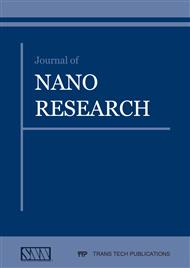[1]
R. Wititsuwannakul, K. Rukseree, K. Kanokwiroon. A rubber particle protein specific for Hevea latex lectin binding involved in latex coagulation, J. Phytochemistry. 69 (2008) 1111-1118.
DOI: 10.1016/j.phytochem.2007.12.007
Google Scholar
[2]
S. Utara, J. Klinkaewnarong. Sonochemical synthesis of nano-hydroxyapatite using natural rubber latex as a templating agent, J. Ceram Int. 41 (2015) 14860-14867.
DOI: 10.1016/j.ceramint.2015.08.018
Google Scholar
[3]
S. Wang, J.H. Liu, Y.X. Wu. Micromorphological characterization and label-free quantitation of small rubber particle protein in natural rubber latex, J. Anal Biochem. 499 (2016) 34-42.
DOI: 10.1016/j.ab.2016.01.015
Google Scholar
[4]
E. Kalkornsurapranee, K. Sahakaro, A. Kaesaman. Influence of Reaction Volume on the Properties of Natural Rubber-g-Methyl Methacrylate, J. Elastom Plast. 42 (2010) 17-34.
DOI: 10.1177/0095244309345410
Google Scholar
[5]
A. Mahittikul, P. Prasassarakich, G.L. Rempel. Hydrogenation of natural rubber latex in the presence of [Ir(cod)(PCy3)(py)]PF6, J. Mol Catal a-Chem. 297 (2009) 135-141.
DOI: 10.1016/j.molcata.2008.09.006
Google Scholar
[6]
S.T. Wang, XH; Sun, JY; Liu, J ; Duan, JC. Sonochemical synthesis of nano-hydroxyapatite using natural rubber latex as a templating agent, J. Appl Polym Sci. 133 (2016).
Google Scholar
[7]
W.C. Chen, S.M. Lai, Z.C. Liao. Properties and preparation of olefin block copolymer/thermoplastic polyurethane blends, J. Appl Polym Sci. 133 (2016).
DOI: 10.1002/app.43703
Google Scholar
[8]
M.T. Ramesan. Effect of Silica on Uncompatibilized and Compatibilized Styrene Butadiene Rubber and Nitrile Rubber Blends, J. Int J Polym Mater 60. (2011) 1130-1146.
DOI: 10.1080/00914037.2011.553857
Google Scholar
[9]
C.C. Ho, M.C. Khew, Y.F. Liew. Surface morphology of asymmetric latex film prepared from blends of natural rubber and poly(methyl methacrylate) latexes, J. Surf Interface Anal. 32 (2001) 133-143.
DOI: 10.1002/sia.1024
Google Scholar
[10]
P. Wongthong, C. Nakason, Q.M. Pan. Modification of deproteinized natural rubber via grafting polymerization with maleic anhydride, J. Eur Polym J. 49 (2013) 4035-4046.
DOI: 10.1016/j.eurpolymj.2013.09.009
Google Scholar
[11]
C. Nakason, W. Pechurai, K. Sahakaro. Rheological, mechanical and morphological properties of thermoplastic vulcanizates based on NR-g-PMMA/PMMA blends, J. Polym Advan Technol. 16 (2005) 592-599.
DOI: 10.1002/pat.634
Google Scholar
[12]
C. Nakason, A. Tobprakhon, A. Kaesarnan. Thermoplastic vulcanizates based on poly(methyl methacrylate)/epoxidized natural rubber blends: Mechanical, thermal, and morphological properties, J. Appl Polym Sci. 98 (2005) 1251-1261.
DOI: 10.1002/app.21908
Google Scholar
[13]
C. Nakason, S. Saiwaree, S. Tatun. Rheological, thermal and morphological properties of maleated natural rubber and its reactive blending with poly(methyl methacrylate), J. Polymer Testing. 25 (2006) 656-667.
DOI: 10.1016/j.polymertesting.2006.03.011
Google Scholar
[14]
Z. Oommen, S. Thomas. Interfacial activity of natural rubber-g-poly(methyl methacrylate) in incompatible natural rubber/poly(methyl methacrylate) blends, J. Polym Bull. 31 (1993) 623-628.
DOI: 10.1007/bf00297901
Google Scholar
[15]
J.Z. Ma, Q.N. Xu, D.G. Gao. Effect of Hydrogen-Bonding Interaction on the Properties of Caprolactam-modified Casein/Waterborne Polyurethane Composite, J. Advanced Materials Research. 160-162 ( 2010) 1090-1094.
DOI: 10.4028/www.scientific.net/amr.160-162.1090
Google Scholar
[16]
N. Suzuki, A. Fujimura, T. Nagai. Antioxidative activity of animal and vegetable dietary fibers, J. Biofactors. 21 (2004) 329-333.
DOI: 10.1002/biof.552210164
Google Scholar
[17]
P. Aramwit, S. Ekasit, R. Yamdech. The development of non-toxic ionic-crosslinked chitosan-based microspheres as carriers for the controlled release of silk sericin, J. Biomed Microdevices. 17 (2015).
DOI: 10.1007/s10544-015-9991-4
Google Scholar
[18]
Mahesh N Padamwar, Atmaram P Pawar, Aarti V Daithankar. Silk sericin as a moisturizer: an in vivo study, J. Journal of Cosmetic Dermatology. 4 (2005) 250-257.
DOI: 10.1111/j.1473-2165.2005.00200.x
Google Scholar
[19]
J. Sun, X. Tian. Study on Natural Rubber Latex Modified by Silk Grafting, J. CHINA ELASTOMERICS. 21 (2011) 10-15.
Google Scholar
[20]
Y. SUN, X. Tian. Chitosan-sericin covalent compounds in the application of the natural rubber latex modification, J. NEW CHEMICAL MATERIALS. 41 (2013) 184-190.
Google Scholar
[21]
Y.S. Vygodskii, T.V. Volkova, O.N. Pashkova. Anionic polymerization of epsilon-caprolactam and its copolymerization with omega-dodecanelactam in the presence of aromatic polyimides, J. Polym Sci Ser a+. 48 (2006) 557-562.
DOI: 10.1134/s0965545x06060010
Google Scholar
[22]
C.M. Zhou, Y.L. Shi, C.S. Sun. Thin-film composite membranes formed by interfacial polymerization with natural material sericin and trimesoyl chloride for nanofiltration, J. Membrane Sci. 471 (2014) 381-391.
DOI: 10.1016/j.memsci.2014.08.033
Google Scholar
[23]
W. Pichayakorn, J. Suksaeree, P. Boonme. Preparation of Deproteinized Natural Rubber Latex and Properties of Films Formed by Itself and Several Adhesive Polymer Blends, J. Ind Eng Chem Res. 51 (2012) 13393-13404.
DOI: 10.1021/ie301985y
Google Scholar
[24]
M. Hussein, R. El-Shishtawy, B. Abu-Zied. The impact of cross-linking degree on the thermal and texture behavior of poly(methyl methacrylate), J. JOURNAL OF THERMAL ANALYSIS AND CALORIMETRY. 124 (2016) 709-717.
DOI: 10.1007/s10973-016-5240-1
Google Scholar
[25]
N.D. Singho, N.A.C. Lah, M.R. Johan. FTIR Studies on Silver-Poly(Methylmethacrylate) Nanocomposites via In-Situ Polymerization Technique, J. Int J Electrochem Sc. 7 (2012) 5596-5603.
DOI: 10.1016/s1452-3981(23)19646-5
Google Scholar
[26]
R. Zhao, X. Li, B.L. Sun. Electrospun chitosan/sericin composite nanofibers with antibacterial property as potential wound dressings, J. Int J Biol Macromol. 68 (2014) 92-97.
DOI: 10.1016/j.ijbiomac.2014.04.029
Google Scholar
[27]
K. Nawamawat, J.T. Sakdapipanich, C.C. Ho. Surface nanostructure of Hevea brasiliensis natural rubber latex particles, J. Colloid Surface A. 390 (2011) 157-166.
DOI: 10.1016/j.colsurfa.2011.09.021
Google Scholar
[28]
C.C. Ho, M.C. Khew. Low glass transition temperature (T-g) rubber latex film formation studied by atomic force microscopy, J. Langmuir. 16 (2000) 2436-2449.
DOI: 10.1021/la990192f
Google Scholar
[29]
E. Laguna-Gutierrez, C. Saiz-Arroyo, J.I. Velasco. Low density polyethylene/silica nanocomposite foams. Relationship between chemical composition, particle dispersion, cellular structure and physical properties, J. Eur Polym J. 81 (2016) 173-185.
DOI: 10.1016/j.eurpolymj.2016.06.001
Google Scholar
[30]
L. Thiraphattaraphun, S. Kiatkamjornwong, P. Prasassarakich. Natural rubber-g-methyl methacrylate/poly(methyl methacrylate) blends, J. Appl Polym Sci. 81 (2001) 428-439.
DOI: 10.1002/app.1455
Google Scholar
[31]
S. Rolere, S. Liengprayoon, L. Vaysse. Investigating natural rubber composition with Fourier Transform Infrared (FT-IR) spectroscopy: A rapid and non-destructive method to determine both protein and lipid contents simultaneously, J. POLYMER TESTING. 43 (2015).
DOI: 10.1016/j.polymertesting.2015.02.011
Google Scholar
[32]
P. Saramolee, N. Lopattananon, K. Sahakaro. Preparation and some properties of modified natural rubber bearing grafted poly(methyl methacrylate) and epoxide groups, J. Eur Polym J. 56 (2014) 1-10.
DOI: 10.1016/j.eurpolymj.2014.04.008
Google Scholar
[33]
X.D. She, C.Z. He, Z. Peng. Molecular-level dispersion of graphene into epoxidized natural rubber: Morphology, interfacial interaction and mechanical reinforcement, J. Polymer. 55 (2014) 6803-6810.
DOI: 10.1016/j.polymer.2014.10.054
Google Scholar


